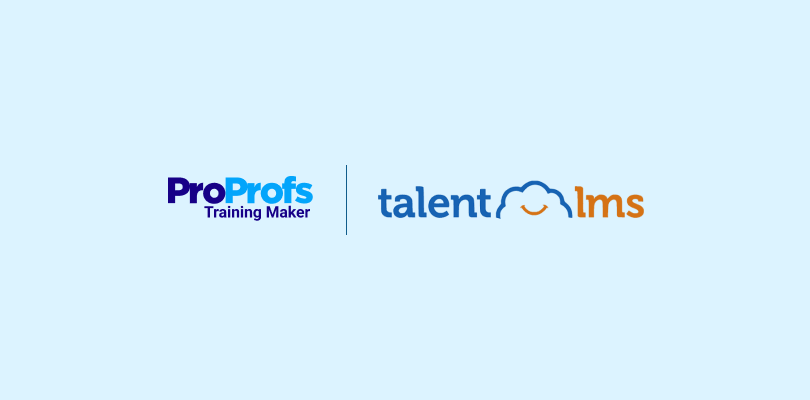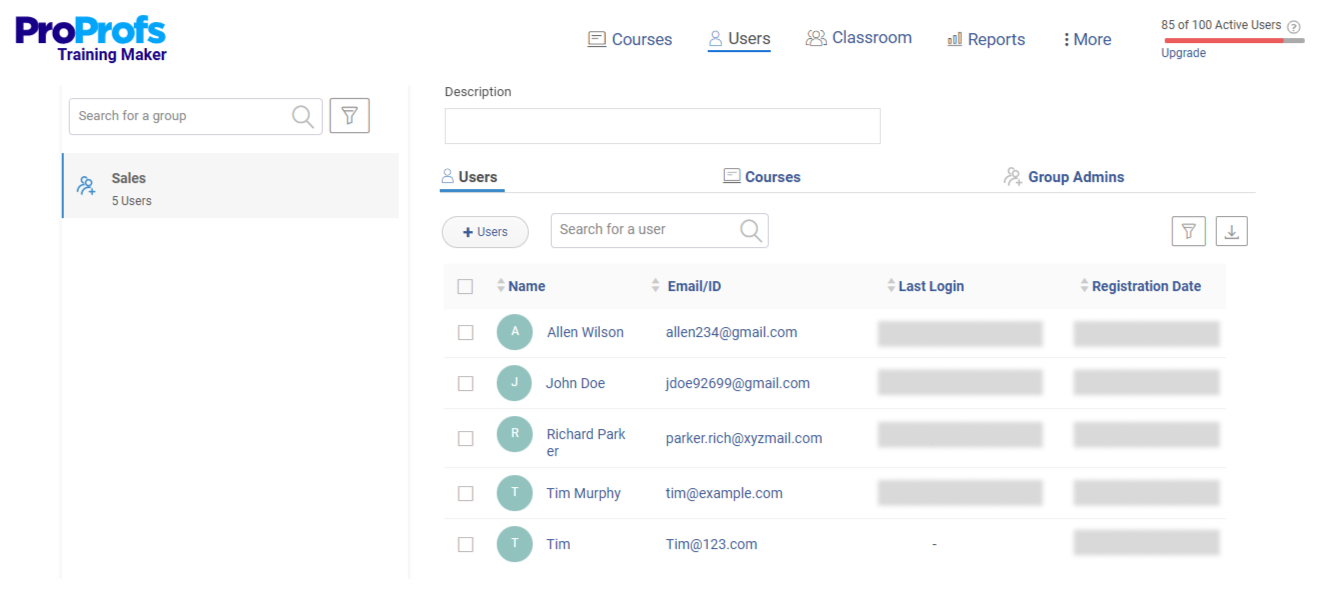Are you finding LMS reporting overwhelming? You’re not alone!
Many HR managers, training professionals, and business owners face the same issues.
The data is there, but it’s difficult to process. It’s like trying to drink from the firehose!
Important insights get lost. Training programs suffer. Employee performance doesn’t improve.
You fall behind competitors!
But it doesn’t have to be this way.
In this guide, I will show you how to turn your LMS data into a powerful tool. I’ll help you uncover the hidden value in your LMS reporting.
You’ll learn how to save time with easy-to-understand reports. Track key metrics like course completions, quiz scores, and knowledge gaps. Access reports for individuals, groups, and entire teams.
In this article, I’ll show you how to turn your LMS data into a powerful tool.
I’ll explain the different types of LMS reports you can generate including individual, group, and cohort LMS reports.
We’ll discuss the tangible benefits LMS reporting brings to your programs, and walk through the best practices that could enhance your approach to training.
What Is LMS Reporting and Analytics?
LMS reporting and analytics involve collecting and analyzing data to track and improve the effectiveness of your training programs.
It’s about turning raw data into actionable insights.
You get detailed reports on various aspects of the learning process, like learner engagement, course completion rates, assessment scores, and time spent on learning activities.
These reports help instructors, trainers, and administrators see how well learners are doing and spot areas for improvement.
LMS reporting is crucial for making informed decisions about course content, teaching methods, and overall training strategies. This ensures your educational goals are met efficiently and effectively.
What Are the Benefits of LMS Reporting?
I remember the first time I realized the power of LMS reporting. It was during one of those quarterly reviews where you usually expect the usual buzzwords to fly around—engagement, metrics, user feedback. Instead, we got a deep dive into data that was honestly more revealing than a detective novel!
We had introduced a new course on digital marketing, and the engagement rates were not at the expected level.
Initially, we thought the content might be too complex, or the platform was acting up. But we discovered something unexpected, thanks to our LMS’s detailed reporting tools.
The drop-off rate was particularly high in the section about SEO. The video tutorial was too long, and learners lost interest halfway through.
This insight was a game-changer. We quickly revised the SEO segment, splitting it into shorter, more digestible videos.
Almost like magic, the completion rates soared, and suddenly, we were not just trainers but heroes in the eyes of the marketing department!
So, what are the benefits of LMS reporting? Let me count the ways:
- Pinpointing Problems: Like in my case, LMS reporting helps you identify areas where learners struggle, allowing quick and effective interventions.
- Improving Content: Continuous feedback from reports lets you refine and optimize the content. It’s like having a quality control team that works 24/7.
- Tracking Progress: Whether it’s seeing how many learners completed a course or how well they did on assessments, these reports keep a pulse on your training’s effectiveness.
- Supporting Decisions: Data from reports can support strategic decisions, from resource allocation to future course development.
- Boosting Engagement: By understanding the learner’s journey through the data, you can craft more engaging and relevant experiences that keep them coming back for more.
And there you have it. So reports are not just about collecting data—it’s about transforming that data into actionable insights that can lead to real improvements and, occasionally, save the day!
Essential LMS Reporting Features to Enhance Training Engagement
As someone who works with training and development, I know the importance of tracking learners’ progress. That’s where LMS reports come in. They’re like a window into the learning process, allowing you to see how effectively your training programs reach your audience.
But what features should an LMS report cover? This is what I’ll discuss.
These are the essential LMS reporting features that any LMS would offer you:
- Learner progress and course completion: This is where I can see how many learners have started, completed, or are stuck somewhere in a particular course. It’s like a headcount for the training program.
- Course and module details: I can dive deeper and see how learners interact with specific modules within a course. This helps identify if any sections are particularly confusing or overwhelming.
- Time spent on learning activities: This report tells me how much time learners spend on different activities within the LMS, such as watching videos, taking quizzes, or participating in discussions.
Now, these are the features that make your LMS reporting shine: - Engagement metrics: Beyond completion rates, these reports track how often learners access the LMS, how long they stay on a particular section, and where they drop off. This helps them understand how well the training material is holding their attention.
- Leaderboards: This injects a friendly competitive spirit into the learning process. Learners can see their progress compared to their peers, which can motivate them to push further. (But be sure to design it to encourage healthy competition!)
- Content engagement reports: These reports go beyond time spent and tell me how learners are interacting with the content itself. Did they actively participate in discussions, download resources, or retake quizzes? This gives a clearer picture of how deeply they’re engaging with the material.
- Survey reports: LMS reporting can integrate with surveys to capture learner feedback directly after completing a course or module. This provides valuable insights into their experience and helps identify areas for improvement.
These are just some of the features you might find in an LMS report card. The key is choosing an LMS that offers reporting that aligns with your training goals and helps you understand how effectively your learners engage with the material.
Track Employee Training Progress Hassle-Free
Enhance your LMS with advanced reporting tools.
LMS Reporting Requirements for Effective Training Evaluation
I’ve purposely created this section because there’s a common misconception that LMS reporting features and reporting requirements are the same. While features provide data, requirements define the specific data points crucial for effective training evaluation.
Now, let’s understand the essential reporting requirements that help assess the impact of your training programs:
- Assessment Performance:
- Requirement: Analyze average scores, pass/fail rates, and individual scores.
- How: Use this data to identify knowledge gaps and areas needing improvement in the training content or delivery methods.
- What: Look for trends in specific question performance to see if assessments accurately measure the intended learning objectives.
- Learning Outcomes:
- Requirement: Track completion rates for assessments and knowledge checks.
- How: Use these completion rates to gauge overall comprehension of the training material.
- What: Consider reports on pre- and post-training assessments to measure knowledge gain and effectiveness of the training program.
- Learner Feedback:
- Requirement: Integrate LMS reporting with surveys to capture post-training feedback.
- How: Ask learners about content clarity, delivery methods, and overall effectiveness of the training.
- Why: Analyze open-ended responses for specific areas of improvement.
- Application & Retention:
- Requirement: Track the application of the acquired knowledge on the job (if applicable).
- How: This could involve manager feedback or follow-up assessments after a specific period.
- What: Analyze this data to see if learners are successfully applying the learned skills and knowledge in their work.
Effective LMS reporting goes beyond simply collecting data. The true value lies in interpreting and using the results to improve future training programs.
For example, if learners consistently score low on a certain module, revising the content or adding more resources might help. When feedback points out that a concept is tricky, maybe we could make it clearer by including interactive elements or real-world case studies to help everyone understand better.
By following these requirements, you can ensure that your LMS reporting provides the necessary data points to evaluate your training programs effectively and make data-driven decisions for improvement.
Get Free LMS Software — All Features, Forever.
We've helped 567 companies train 200,000+ employees. Create courses in under a minute with our AI LMS or use 200+ ready-made courses on compliance, harassment, DEI, onboarding, and more!
9 Types of LMS Reports and Examples
Based on my expertise, I’ve compiled the following types of LMS reporting templates. They can add value to the training initiatives of professionals, such as senior management, HR managers, team leaders, L&D managers, and course instructors.
So, let’s begin!
1. Course Reports – Best for Tracking Course Progress
![]()
Course reports are one of the most valuable LMS reporting types that provide essential insights into the performance and progress of learners within a specific course.
Educators can track individual and overall class performance, identify struggling students, and tailor instructional strategies accordingly.
Course reports in LMS help administrators assess the effectiveness of courses, monitor trends, and make data-driven decisions to improve the overall learning experience.

By analyzing this data, instructors can optimize instructional methods and enhance the educational outcomes for their learners.
Course reports are vital in creating an engaging and effective learning experience for all participants.
For instance, I have tried various LMS reporting tools, such as ProProfs Training Maker, AbsorbLMS, and Docebo, and they have helped me incredibly to keep track of my learners.
Watch: How to Analyze Training Course & Quiz Results
Who Uses It
- Instructors and Trainers: Course reports help instructors and training managers evaluate how well their teaching methods resonate with learners. By analyzing individual performance data, they can identify areas where learners may struggle and adjust their approach accordingly.
- L&D Managers: They rely on course reports to monitor the overall effectiveness of training initiatives. They can identify popular courses, track completion rates, and assess the impact of training on employees’ skills and performance.
How to Use It
- Performance Evaluation: Instructors and L&D managers can use reports to evaluate the effectiveness of the course content and instructional design.
- Identifying Learning Gaps: By analyzing the data from course reports, instructors and L&D managers can identify areas where learners are struggling or not performing as expected.
- Course Improvement: Based on the reports, Instructors and L&D managers can use this information to enhance the course material and improve the overall learning experience.
- Tracking Learner Progress: LMS course reports help track progress, ensuring learners complete the required modules within the specified timeframe.
2. Group Reports – Best for Tracking Collaborative Learning & Teamwork
![]()
Group reports in an LMS provide a consolidated view of the performance and collaboration of groups or teams within a course. These reports allow instructors to analyze how well groups work together on group LMS project reports, assignments, or discussions.
Group reports typically include data on individual contributions, group interactions, communication patterns, task distribution, and overall group performance.
By accessing group reports, you can identify strong and weak areas within each group, assess the level of participation of individual members, and intervene if necessary to ensure equitable group dynamics.
This information will help you provide targeted support and feedback, foster effective teamwork, and promote a collaborative learning environment for learners within the LMS platform.
Watch: How to Enable Collaboration & Discussions in Your Course
Who Uses It
- L&D Managers: Group reports help L&D managers assess the effectiveness of training initiatives and identify trends and patterns within specific learner groups.
- Team Leaders and Supervisors: Group reports are valuable for team leaders and supervisors to monitor the progress of their teams and identify areas where additional support or training might be needed.
How to Use It
- Performance Comparison: Group reports allow L&D managers, team leaders, and supervisors to compare the performance of different learner groups, which helps identify high-performing groups and those that may require additional attention.
- Identifying Training Needs: By analyzing group reports, stakeholders can identify common areas of improvement for specific teams or departments. This information can be used to tailor training programs that address the specific needs of each group.
- Team Building and Collaboration: Group reports can facilitate team-building activities and encourage healthy competition.
- Resource Allocation: L&D managers can allocate training resources more effectively with group reports. They can focus on areas with the greatest need and ensure that training efforts align with the organization’s overall goals.
3. User Reports – Best for Individual Progress Tracking
![]()
User reports in an LMS provide a comprehensive overview of individual performance and progress within the platform.
Data like completed courses, grades, assessments, and learning achievements can be found in these reports. They offer valuable insights into individual strengths, weaknesses, and areas for improvement.
With access to personalized analytics, users can track their learning journey, set SMART goals, and measure their success. These reports also aid instructors and administrators in assessing the effectiveness of their courses, identifying trends, and tailoring learning experiences to meet individual needs.
Who Uses It
- Individual Learners: Users or individual learners are the primary users of user reports. They access these reports to track their progress, view their quiz scores, and monitor their course completion rates.
- Supervisors and Managers: They may also use user reports to get an overview of their team members’ learning progress.
Watch: How to Share Quiz or Course Reports With Your Learners
How to Use It
- Self-Progress Tracking: Individual learners use user reports to track their learning progress. By reviewing their performance, users can identify areas where they need to focus more and assess their overall learning performance.
- Performance Evaluation and Feedback: Supervisors and managers can use these reports to identify areas for improvement and provide constructive feedback during performance discussions.
- Identifying High Performers and Support Needs: User reports allow supervisors and managers to identify employees excelling in their training efforts and the ones who may be struggling or falling behind, leading to discussions about providing additional support or tailored training solutions.
- Decision-Making and Resource Allocation: User reports are often used for employee development, training initiatives, and resource allocation.
4. E-commerce Revenue Reports – Best for Financial Performance Analysis

E-commerce revenue reports are comprehensive summaries of an online store’s financial performance, providing insights into the revenue generated through sales transactions of online courses over a specific period.
These reports typically include data on buyers’ details, items sold, date of purchase, country, total sales, product-specific sales, average order value, and revenue from various channels (e.g., website, mobile app, social media). Additionally, they may offer information on customer demographics, purchase behavior, and conversion rates.
These reports are essential for businesses to assess their sales performance, identify best-selling products, evaluate marketing strategies, and make data-driven decisions to optimize revenue and overall profitability in the highly competitive e-commerce landscape.
Who Uses It
- Business Owners and Managers: Business owners and top-level managers are primary users of e-commerce revenue reports. They rely on these reports to clearly understand the company’s financial performance, track sales trends, and assess overall revenue growth.
- Marketing and Sales Teams: E-commerce revenue reports are used by marketing teams to identify which products or marketing channels drive the most revenue and optimize their efforts accordingly.
How to Use It
- Product and Category Analysis: These reports provide insights into the sales performance of individual products and product categories, which help businesses identify top-selling products and capitalize on successful product lines.
- Marketing and Advertising ROI: By analyzing revenue data alongside marketing and advertising efforts, marketing teams can allocate resources more effectively and focus on strategies that yield the highest revenue.
- Identifying Sales Trends and Patterns: E-commerce revenue reports allow stakeholders to identify sales trends, such as seasonal fluctuations or changing customer preferences.
Watch: How to Sell Your Quizzes and Courses Online
5. Assessment Reports – Best for Measuring Learning Progress

Assessment reports are like your performance scorecards, providing valuable feedback on your learning progress and knowledge retention. These reports are generated after completing quizzes, tests, or assignments within a course. You can view the learner’s name, the time taken to complete the assessment, IP address, etc.
Assessment reports offer detailed insights into your strengths and areas for improvement, helping you understand which topics you’ve mastered and which ones might need more attention.
Such reports not only track your performance but also help instructors and educators identify broader trends in the learning process. By using these reports, you can gauge your learning journey and tailor your study approach for a more successful and fulfilling learning experience.
Watch: How to Review Quiz Reports & Statistics
Who Uses It
- Learners: Assessment reports are valuable tools for learners themselves. They use these reports to gain insights into their individual performance, identify their strengths, and pinpoint areas that require further improvement.
- Instructors and Educators: Instructors use assessment reports to evaluate their teaching methods and course effectiveness. These reports help identify challenging concepts and adjust their instructional approach to better cater to their learner’s needs.
How to Use It
- Personalized Learning Paths: Instructors can use assessment reports to optimize learning journeys based on the learner’s areas of strength and weakness.
- Data-Driven Instruction: Instructors leverage assessment reports to make data-driven decisions, identify common misconceptions, improve course content, and tailor teaching methods to enhance overall learning outcomes.
- Monitoring Progress: Learners and instructors use assessment reports to track progress over time, allowing learners to see their growth, while instructors can gauge the effectiveness of their teaching strategies and make necessary adjustments to ensure continuous improvement.
- Feedback and Support: Assessment reports facilitate meaningful feedback and support for learners.

Instructors can provide targeted guidance to individuals who may be struggling, offering additional resources and encouragement to foster their success.
6. Leaderboard Reports – Best for Identifying Top Learners

Leaderboard reports provide comprehensive information on the user rankings based on specific LMS metrics, such as quiz performance, completion rates, or other tracked activities.
These reports present a competitive element to the learning process, displaying top-performing learners and their achievements.
Leaderboard reports in LMS reporting tools foster motivation and engagement by encouraging healthy competition among learners. Learners can compare their progress with others, motivating them to strive for better results and earn a higher position on the leaderboard.
These reports are popular in gamified learning environments, online courses, and training programs, as they create a sense of accomplishment and recognition, driving continuous improvement and active participation.
Who Uses It
- Learners and Participants: Learners are the primary users of leaderboard reports. They eagerly check their positions on the leaderboard to assess their performance compared to peers and competitors, fueling their motivation to excel and reach higher ranks.
- Instructors and Educators: Instructors use leaderboard reports to foster healthy competition and engagement among learners. By showcasing top performers, instructors can recognize and reward outstanding achievements, encouraging others to strive for excellence.
How to Use It
- Motivation and Engagement: Learners can leverage leaderboard reports as a motivational tool to stay engaged with their learning journey. By seeing their progress in relation to others, they are inspired to put in extra effort to climb up the rankings and achieve recognition.
- Recognizing Achievements: Celebrating top performers fosters a positive learning environment, encouraging healthy competition and enhancing the overall learning experience.
- Identifies Improvement Areas: By analyzing leaderboard data, instructors can identify learners who may be struggling and provide targeted support or additional resources to help them improve their performance.
- Promotes Social Learning: Leaderboard reports help learners to connect, share knowledge, and collaborate to enhance their understanding of course materials.
7. Enrollment History Reports – Best for Compliance Monitoring

Another LMS reporting example includes enrollment history reports, which contain the details of an individual’s or a group’s enrollment activities within an LMS over a specific period. These reports capture details like course enrollments, enrollment dates, and completion status.
Enrollment history reports provide valuable insights into learners’ learning pathways, helping track their progress and participation in various courses and training programs. They are essential tools for learners, instructors, and administrators to monitor training initiatives, identify enrollment trends, and assess the effectiveness of educational offerings.
These reports also aid in compliance tracking, allowing organizations to ensure that learners meet mandatory training requirements and certifications through timely course enrollments and completions.
Who Uses It
- Learners and Students: Learners are the primary users of enrollment reports. They access these reports to review their course enrollments, track their learning progress, and ensure they are on the right path to completing their desired courses.
- Administrators and Course Coordinators: These stakeholders also use enrollment reports to manage course enrollments, monitor learner participation, and ensure smooth course registration and allocation of resources.
How to Use It
- Course Planning and Scheduling: Learners can use enrollment reports to plan their learning journey. By reviewing available courses and enrollment dates, they can strategically schedule learning and ensure they register for courses aligned with their learning goals.
- Resource Allocation and Capacity Planning: By analyzing enrollment data, administrators and course coordinators can determine the demand for specific courses and allocate instructors and materials accordingly.
- Progress Monitoring and Support: If a learner encounters challenges or withdraws from a course, administrators can offer timely support and guidance to ensure the learner’s success.
- Identifying Popular Courses: Enrollment reports provide valuable insights into the popularity of courses and training programs. Administrators can use this data to identify trends and offer more of the most sought-after courses to meet learners’ preferences and demands.
8. Survey Reports – Best for Feedback and Improvement Insights

Within an LMS, survey reports are another type of reporting and analytics, containing compiled data from surveys and feedback forms completed by learners, instructors, or other stakeholders.
These reports analyze the responses provided, extracting valuable insights and trends. They help administrators and course creators understand learners’ opinions, satisfaction levels, and feedback on various aspects of the learning experience.
Additionally, survey reports help identify areas that require improvement, assess the effectiveness of training programs, and make data-driven decisions to enhance the overall learning environment and course content.
Who Uses It
- Course Creators and Instructors: Course creators and instructors rely on these reports to gather feedback from learners about their course content, teaching methods, and overall learning experience. This enables them to assess the effectiveness of their courses and make improvements based on learners’ input.
- Administrators and L&D Managers: These stakeholders use survey reports to gain insights into the overall satisfaction of learners with the LMS platform and training programs. They can identify trends, assess the quality of training initiatives, and address any areas for improvement.
How to Use It
- Course Enhancement and Personalization: Survey reports help identify specific areas where learners require additional support or clarification. By analyzing feedback, instructors can customize the course content to cater to learners’ needs, creating a more engaging and personalized learning experience.
- Continuous Improvement and Decision-Making: The survey data guides the decision-making processes, allowing instructors to implement changes that enhance user satisfaction and better learning outcomes.
- Assessment of Training Effectiveness: By gathering feedback on the learning experience through reports, administrators and instructors can make data-driven decisions to enhance training initiatives and achieve better learning outcomes.
- User Engagement and Retention: By understanding what aspects of the learning experience resonate positively with learners, stakeholders can implement strategies to increase user engagement and promote higher retention rates.
9. Certification Reports – Best for Compliance Tracking and Verification
![]()
Certification reports provide data on learners’ achievements and compliance with specific training or certification requirements. These reports compile data on learners who have completed designated courses or training programs and obtained relevant certifications or accreditations.
The reports may include information such as the names of certified learners, course completion dates, certification validity periods, and any associated credentials earned.
Certification reports are essential for organizations to track and verify the compliance of their employees or learners with industry standards, regulatory requirements, or internal training goals. These reports ensure learners meet the qualifications and maintain up-to-date certifications for their roles or professions.
Watch: How to Create Custom Certificates With Your Own Logo and Branding
Who Uses It
- Learners and Professionals: Learners and professionals access these reports to view and download their earned certificates as proof of completing specific courses or training programs successfully.

- Human Resources and Compliance Managers: These reports help ensure the HR and compliance managers that employees meet the required qualifications and maintain up-to-date certifications as per organizational or regulatory standards.
How to Use It
- Credential Showcase: Learners and professionals can use certificate reports to showcase their earned credentials to potential employers or clients. Learners can strengthen their resumes and professional profiles by providing tangible evidence of their training and achievements.
- Compliance Verification: HR and compliance managers use certificate reports to verify that employees have completed mandatory training or certifications. These reports help ensure compliance with industry regulations, internal training requirements, and safety standards.
- Performance Recognition: Certificate reports serve as a means of recognizing and celebrating learners’ accomplishments. Organizations can acknowledge top performers and provide incentives to encourage continuous learning and skill development.
- Training Program Evaluation: By analyzing certificate reports, HR and L&D managers can evaluate the effectiveness of training programs. These reports can help identify popular courses, assess completion rates, and gauge the overall impact of training initiatives on employee skill development.
Harness the Power of LMS Reporting and Analytics!
In the realm of modern education and training, LMS reporting and analytics are essential for success. As an industry expert, I’ve shared the top nine types to track training. From monitoring progress to assessing performance, understanding engagement, and optimizing learning paths, these insights are invaluable in guiding training programs.
Embrace the potential of LMS reporting to enhance training outcomes, boost learner satisfaction, and ultimately elevate your organization’s success. Let data be your guiding light, illuminating the path to a brighter, more efficient future in training and development.
What Are the Best Practices for Implementing LMS Reporting?
When implementing LMS reporting in a corporate environment, best practices can ensure the process is effective. I have curated a set of practices that might just save you from drowning in data or the boredom of endless spreadsheets! (Trust me, it saved me a lot!).
- Define Clear Objectives: Before you dive into the data, know what you want from it. Are you tracking compliance, engagement, or performance? Each goal requires different metrics, so set your targets early.
- Customize Reports for Different Audiences: Not everyone loves number crunching. Customize your reports to suit the audience. Executives might prefer high-level dashboards, while trainers need detailed reports on learner progress.
- Automate Wherever Possible: Automate mundane tasks to save time and avoid errors. Scheduled reports can automatically update stakeholders on key metrics, keeping everyone in the loop without manual intervention.
- Use Visuals to Simplify Data: A picture is worth a thousand spreadsheets. Use graphs, charts, and heat maps to make data easier to digest. This way, you might keep everyone awake during those monthly report meetings!
- Regularly Review and Revise Reporting Practices: What worked last year might not work this year. Review your reporting practices regularly to ensure they still meet corporate needs and make adjustments as necessary.
- Train Your Team: Ensure everyone uses the LMS reporting tools effectively. A little training can go a long way in improving the accuracy and usefulness of your reports.
- Encourage Feedback: Sometimes, the best improvements come from the users themselves. Encourage feedback on the reports from all levels within the organization. This can lead to valuable insights that no amount of data can show.
- Maintain Data Integrity and Security: Last but not least, ensure your data is accurate and secure. Reliable data builds trust in the reports, and securing this data protects your learners’ privacy.
Implementing these best practices will improve your LMS reporting and add a bit of flair to the usually dreary task of dealing with data. After all, who says you can’t have fun with figures?
Elevate Your Training With LMS Reporting and Analytics!
Don’t let LMS reports gather dust! These data hold the power to transform your training. Use them wisely to identify areas for improvement, personalize learning journeys, and refine course content.
By analyzing data and taking action, you can create a dynamic environment that fosters engagement, boosts knowledge retention, and takes your learners toward success. Explore gamification features within your LMS to add a fun twist and keep motivation high.
Remember, LMS reporting is an ongoing journey – keep iterating based on insights for continuous improvement!
 Tips
Tips
We’d love to hear your tips & suggestions on this article!
Get Free LMS Software — All Features, Forever.
We've helped 567 companies train 200,000+ employees. Create courses in under a minute with our AI LMS or use 200+ ready-made courses on compliance, harassment, DEI, onboarding, and more!

 We'd love your feedback!
We'd love your feedback! Thanks for your feedback!
Thanks for your feedback!







